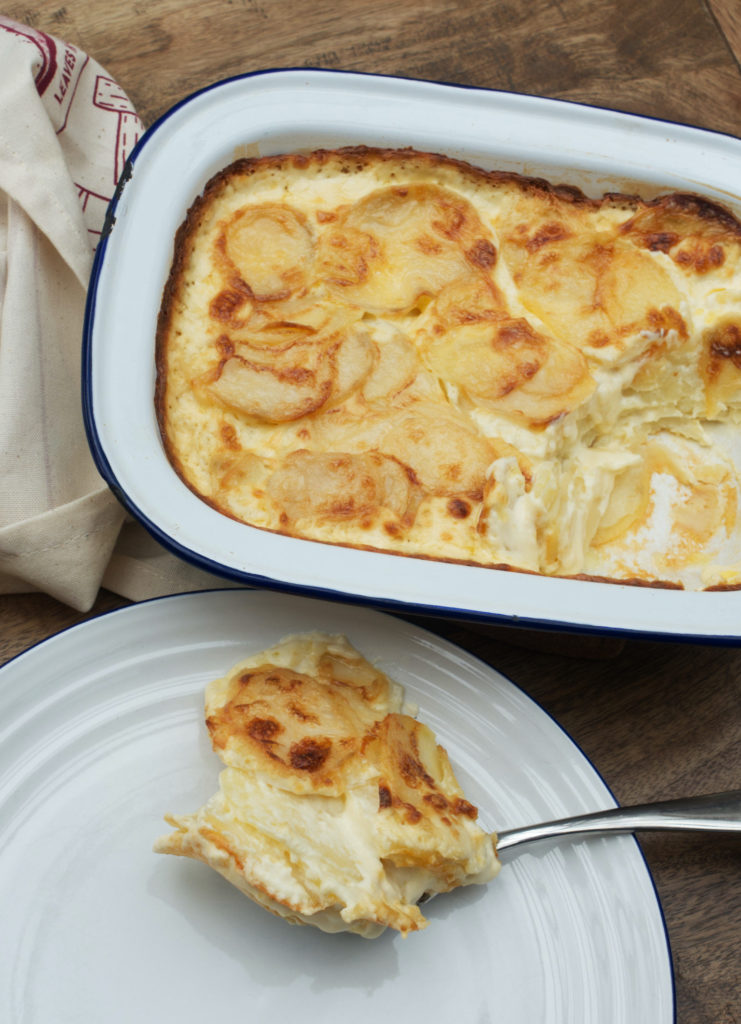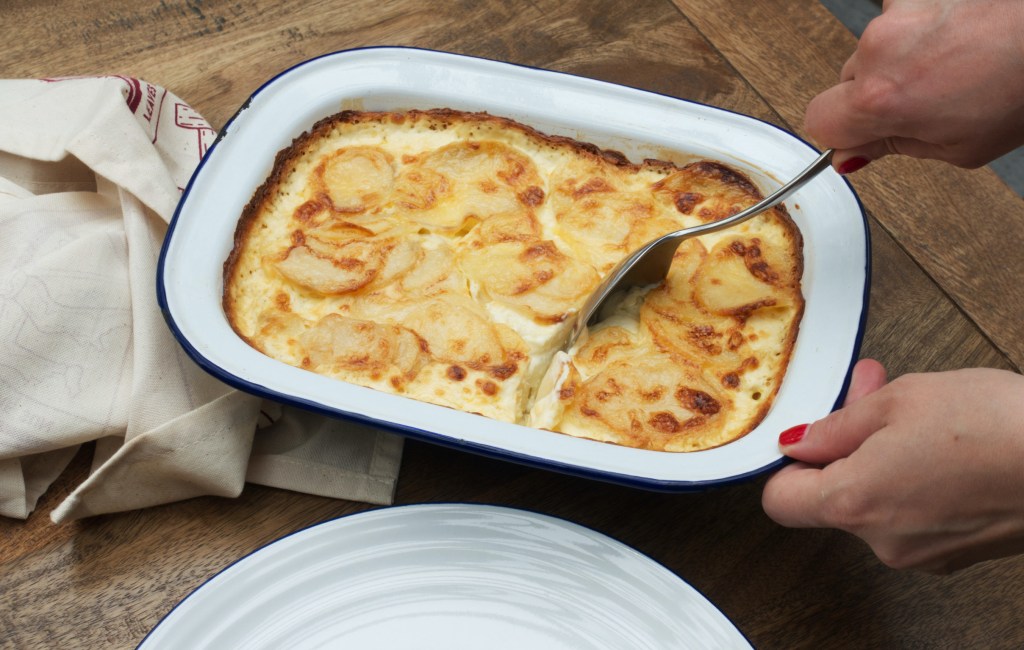There’s no getting away from the fact that scalloped potatoes is a rich dish. It’s a celebration of richness, of creaminess — and of carbs. If you recoil from richness, or are the first person at the table to bring up calorie counts, scalloped potatoes is probably not for you — and frankly, any attempts to lighten it, or slim it down are misguided. But if you can resist bronzed slabs of thin, tender, perfectly cooked potato, with a garlic-infused creamy sauce bubbling up around the edges, you’re made of sterner stuff than I am.
Scalloped potatoes is known as potatoes dauphinoises in Europe and hails from the historical Dauphiné region in southeast France; the region dissolved in 1789 but its potato namesake has lived on. For all its richness, it’s a simple dish — potatoes oven-baked in cream with a little garlic — but one that is host to countless variations: different proportions of milk and cream, homeopathic amounts of garlic or enough to scare away vampires, additions of herbs — thyme, usually — or cheese. Normally, I can’t resist a little lily-gilding, but actually when it comes to scalloped potatoes, I’d rather keep things simple. I like enough garlic that you can smell it in the air when you pull the dish from the oven, but not so much that it obliterates the mellow flavors of cream and potato. And technically, adding cheese turns it into a slightly different dish — potatoes savoyarde — but rather than being a stickler for authenticity, my objection is that I think it changes the nature of the dish. The thing is, melted, stringy cheese always takes the starring role, no matter how good the other components, and it’s simply not needed here for the potatoes to shine.
There’s always something quite soothing about reducing a pile of potatoes to slices, and then placing them in even layers, which makes scalloped potatoes a rather satisfying dish to make. In my version, the cream and milk are infused with thin slices of garlic, brought up to a simmer and then left to stand. The potatoes are then sliced into slabs: a mandoline makes short work of this task, and results in beautifully thin, even, slightly floppy potato slices (I tend to to use the thickest setting on my mandoline for this dish), but a sharp knife and a little patience will also serve you well. And while I don’t wish to nag, if you use a mandoline, please use an adequate guard or slash-proof glove.
Here, I deviate from strict tradition: technically the potatoes should enter the oven raw. But there is nothing sadder than biting into a slightly undercooked potato, so I make no apology for briefly simmering the potatoes in the milk and cream mixture first. It also has the advantage of thickening the cream sauce with starch from the potatoes, making it even silkier. But, please, learn from my mistakes, and use a really big pot for this: the last thing you want is starchy, creamy potato liquid bubbling all over your hobs. The potatoes are transferred to a roasting dish, and the cream is poured over them until it comes just below the top level of potatoes, and then the whole thing is transferred to a low-ish oven for an hour. This makes it a great hosting dish: you can prepare it in advance up until the point where it enters the oven — and from thereon in, it’s hands off.
The dish reheats well, too, which puts it in my favorite category of dishes: impressive but easy make-aheads. You can be cheffy, if you fancy, by chilling the whole thing down and then slicing it into neat little squares. But, to be honest, this is the kind of dish I want to present whole at the table, with an enormous serving spoon, and just let people dig in.

Scalloped potatoes
Makes: Serves 6-8
Takes: 15 minutes
Bakes: 1 hour
2 lbs 3 oz Maris Piper potatoes
14 oz double cream
6¾ fl oz milk
3 cloves garlic, thinly sliced
- Place the milk, cream and garlic into a really large pan, bring to a simmer, and then turn off the heat and leave to stand while you prepare the potatoes
- Peel the potatoes; then slice them thinly and evenly using a mandoline or a sharp knife
- Preheat the oven to 320°F. Add the sliced potatoes to the milk and cream mixture, and place over a medium heat. Bring back up to a simmer, then cook until the potatoes are just starting to become tender (they will lose their absolute rigidity and flop over a little when you lift them). Keep an eye on them: you don’t want the pan to overboil, the potatoes to stick to the bottom of the pan, or for them to overcook and fall apart
- Using a slotted spoon, transfer the potatoes to a roasting dish: you want a reasonable layer of potatoes, about an inch deep, so don’t use a massive dish, mine is 12″ by 8″, but there’s a lot of tolerance here. Season with salt between the layers of potatoes as you add them. Pour the garlicky creamy mixture over the potatoes until it comes just below the top layer of potatoes — you may not need all of it
- Bake for an hour until the potatoes are golden-brown and crisp on top. If, for whatever reason, your potatoes haven’t burnished to your liking, you can turn the oven up to 430°F for five minutes, or flash the whole thing under a medium-hot grill
This article was originally published on Spectator Life.


















